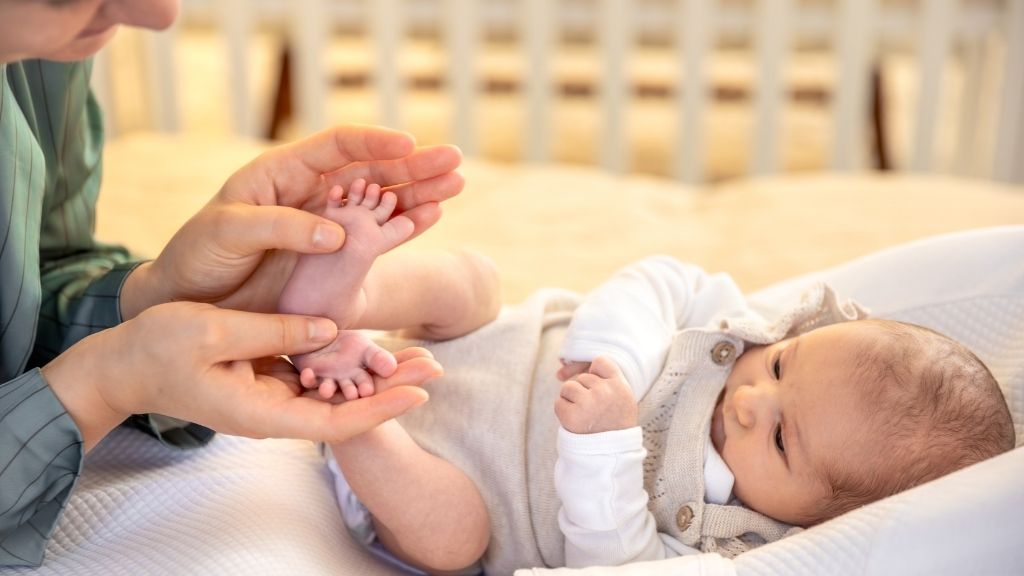Watching your newborn’s tiny movements can be both fascinating and worrying. Many parents notice sudden jerks, grasping fingers tightly, or even stepping motions and wonder, “Is this normal?” The reassuring answer is yes. These movements are called newborn reflexes, and they are a healthy sign of your baby’s development.
Every baby is born with natural reflexes automatic responses that help them survive and grow. Some reflexes disappear after a few months, while others lay the foundation for skills like crawling and walking. Understanding what these reflexes are, why they happen, and when to expect changes can give you peace of mind during those first precious months.
This guide combines personal parenting insight with expert backed information from trusted sources such as the NHS and the American Academy of Pediatrics. We’ll explore the most common reflexes in babies, explain their purpose, and highlight when to consult your doctor. Along the way, you’ll find practical tips and reassurance to help you navigate this exciting stage with confidence.
What Are Baby Reflexes?
Newborn reflexes are automatic, involuntary movements triggered by specific actions or touches. They are present at birth and reflect your baby’s nervous system health. According to the NHS Start for Life, reflexes are key indicators that a baby’s brain and nerves are working properly.
For example, if you stroke your baby’s cheek, they may turn toward you and start sucking. This is called the rooting reflex and helps them find food.
In simple terms: reflexes are nature’s way of preparing your baby for survival and growth.
Expert Tip: Reflexes are tested by midwives and paediatricians shortly after birth. They give vital clues about your baby’s neurological development.
Why Do Babies Have Reflexes?
Reflexes serve important roles, such as helping babies feed, protecting them from harm, and setting the stage for motor skills. Parents often notice these reflexes most during everyday care routines.
Here are some common reasons they occur:
- Survival: Reflexes like rooting and sucking help babies feed.
- Protection: Reflexes like the Moro (startle) reflex prepare them to react to danger.
- Development: Reflexes like stepping show the body practicing skills it will use later.
- Communication: Since babies cannot speak, reflexes give clues about their needs and health.
Over time, many reflexes fade as your baby’s brain develops and voluntary control takes over. For example, the rooting reflex gradually turns into purposeful head turning when looking for food. The stepping reflex, which disappears around 2 months, later reappears as a conscious action when babies learn to walk. This natural progression shows how reflexes are stepping stones toward milestones rather than permanent behaviors.
This often surprises parents: your baby’s jerky movements are not random they are meaningful signals of healthy development.
Parent Tip: If a reflex seems strong or startles you, remind yourself it’s a natural stage. Most reflexes fade by 6 months.
Signs to Notice and When to Consult
Most reflexes are harmless and part of normal development. However, pay attention if:
- Reflexes are missing or only occur on one side.
- Reflexes persist beyond the expected age.
- Your baby feels floppy or unusually stiff.
- Your baby does not respond to touch, sound, or light consistently.
Most cases are mild and not harmful, but always trust your instincts. If something feels unusual, it’s best to check with your GP or health visitor.
Sometimes parents notice differences between babies, even within the same family. For example, one baby may have a very strong Moro reflex while another barely startles. Both can be normal. What matters most is whether your baby responds consistently over time. Think of reflexes as a snapshot of development, not a pass or fail test.
Common Infant Reflexes Explained
Here are the main reflexes you’re likely to see in your newborn:
Rooting Reflex
If you stroke your baby’s cheek, they turn their head toward the touch and open their mouth. This helps them find the breast or bottle. It usually disappears by 4 months.
Sucking Reflex
Triggered when something touches the roof of the baby’s mouth. Essential for feeding, this reflex is strongest in the first months and becomes voluntary around 4 months.
Moro (Startle) Reflex
When startled by a loud sound or sudden movement, babies fling their arms out and then pull them back in. This is most noticeable in the first 3 months and usually disappears by 6 months.
Palmar Grasp Reflex
When you place your finger in your baby’s palm, they grip tightly. This usually fades around 5–6 months.
Plantar Grasp Reflex
Similar to the palmar reflex, but in the feet. When the sole is stroked, toes curl down. Disappears by 12 months.
Stepping Reflex
When held upright with feet touching a surface, babies make stepping motions. This vanishes by 2 months but is a stepping stone to walking.
Tonic Neck Reflex (Fencer’s Pose)
When your baby’s head is turned to one side, the arm on that side straightens, while the opposite arm bends. It usually disappears by 6 months.
Quick Reference Chart for Parents
| Reflex Name | Trigger | Usual Disappearance | Purpose/Meaning |
| Rooting | Stroke cheek | 4 months | Helps baby find food |
| Sucking | Touch roof of mouth | 4 months | Enables feeding |
| Moro (Startle) | Loud sound/movement | 6 months | Protective response |
| Palmar Grasp | Finger in palm | 5–6 months | Early motor development |
| Plantar Grasp | Stroke sole of foot | 12 months | Normal nervous system check |
| Stepping | Feet touch flat surface | 2 months | Prepares for walking |
| Tonic Neck | Head turned to one side | 6 months | Coordination, motor practice |
Pro Tip: Keep this chart handy for baby milestones check ups. It’s reassuring to track reflexes alongside growth.
Safety Do’s and Don’ts
- Do support your baby’s head and neck, especially when the Moro reflex may be triggered.
- Do observe reflexes during everyday care feeding, cuddling, or playtime.
- Do mention any concerns to your GP or health visitor.
- Don’t panic if reflexes feel strong or sudden they are normal.
- Don’t compare your baby to others timelines vary slightly.
- Don’t ignore your instincts if something feels off.
Emotional Reassurance for Parents
If you’re feeling anxious about your newborn’s jerky movements or sudden startles, please don’t blame yourself. Reflexes are not signs of problems but of growth. They show your baby’s brain and body are learning to work together.
As a parent, it’s natural to worry, but remember reflexes are your baby’s first language. With time, these reflexes fade, replaced by smiles, giggles, and first steps.
Parent Tip: Capture these reflexes in photos or videos. They are fleeting moments that you’ll look back on with awe.
Frequently Asked Questions
Do all babies have the same reflexes?
Yes, although strength and timing may vary slightly.
When do most newborn reflexes disappear?
Between 2 and 12 months, depending on the reflex.
Should I worry if my baby’s reflexes seem late to disappear?
Not always, but speak to your GP or health visitor if a reflex lasts beyond its expected time.
Do reflexes affect brain development?
Reflexes themselves do not harm development. They are healthy indicators of brain and nerve activity.
Conclusion
Newborn reflexes are fascinating glimpses into your baby’s development. They serve important roles in feeding, protection, and early learning. Most reflexes are temporary, fading within the first year as your baby gains voluntary control of their movements.
Most cases are harmless, but talk to your GP or health visitor if you are worried.
As a parent, I know how easy it is to worry but remember, you are not alone in this journey. Every reflex is a step toward your baby’s incredible milestones.



